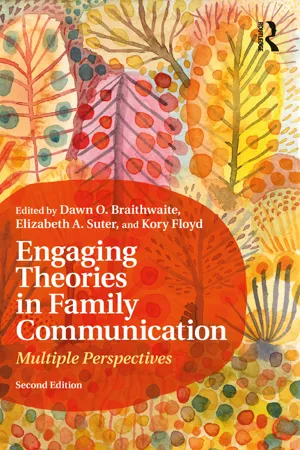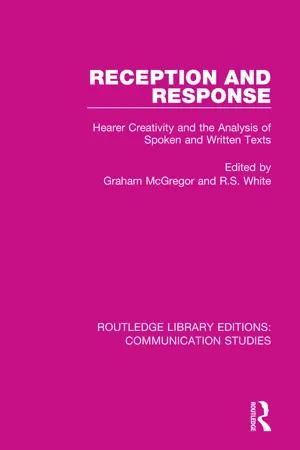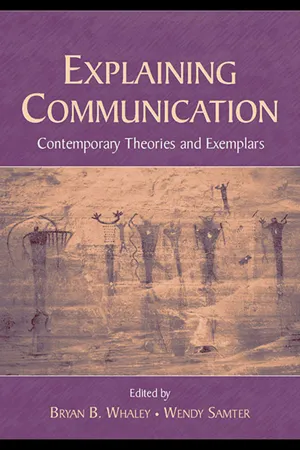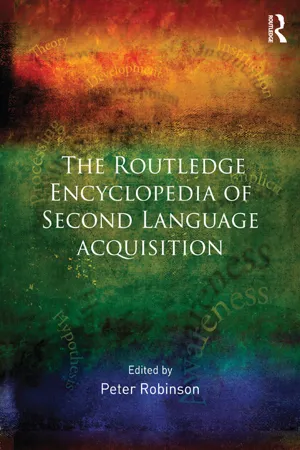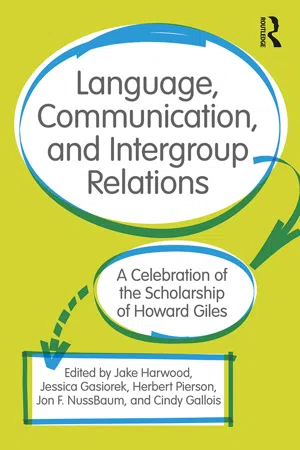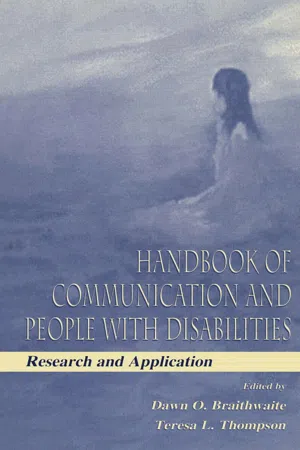Languages & Linguistics
Communication Accommodation Theory
Communication Accommodation Theory (CAT) explores how individuals adjust their communication styles to either converge with or diverge from others. It emphasizes the role of social identity and the desire for social approval in shaping communication behaviors. CAT suggests that accommodation can lead to improved understanding and rapport between speakers, but it can also reinforce social hierarchies and power dynamics.
Written by Perlego with AI-assistance
Related key terms
Related key terms
1 of 4
Related key terms
1 of 3
12 Key excerpts on "Communication Accommodation Theory"
- eBook - ePub
- Vanessa Hammler Kenon, Sunay Vasant Palsole(Authors)
- 2019(Publication Date)
- Wiley-Blackwell(Publisher)
The topic for this chapter is admittedly diverse and of very large scope—large enough to have full‐length books and multiauthor handbooks written on it. This chapter will try to provide an outline of the various angles which can be adopted to study the topic. The next section deals with some preliminary and basic theoretical approaches relevant to the study of intercultural communication. The following section gives brief accounts of prominent concepts and analysis for a better understanding of multilingual scenarios in the current globalized world. The penultimate section gives a few instances of intercultural communication in the workplace, followed by a final, brief, discussion of the issue.Theories Related to Intercultural Communication
Communication Accommodation
Communication Accommodation Theory (CAT ) developed as a theory of interaction during the 1970s (Giles 1973 , 1977 ; Giles, Bourhis, & Taylor, 1977 ) to explain the question of linguistic choices made by interlocutors during the course of a conversation. The theory also offers a critique to the studies that followed the Labovian paradigm (Labov, 1963 , 1966 ) of interpreting variations in languages, which ranked shifts in speech styles in accordance with speakers’ status in the society and with the contexts of the situation in which the conversation is taking place. In the Labovian framework of sociolinguistic analysis, speech variation in an individual is typically correlated with the level of formality of the conversation setting. An increase in the level of formality in conversation results in greater attention being paid to the speech, which in turn would cause a likely shift to a more “prestigious” variety of the language.While accepting in principle the influence of the contextual and social factors in the modification of speech style, CAT proposes that one important factor was overlooked in the Labovian model—the influence of the participants in the interaction process. Giles (1973 - eBook - ePub
Engaging Theories in Family Communication
Multiple Perspectives
- Dawn O. Braithwaite, Elizabeth A. Suter, Kory Floyd(Authors)
- 2017(Publication Date)
- Routledge(Publisher)
By identity, we are referring to idiosyncratic aspects of individual family members (e.g., personality), family members’ connection with various social identities (e.g., religion, ethnic-racial identity, age group, gender), and the overall relational or family culture. Thus, there is a clear intersection between family communication and these different dimensions of identity. Why do we talk with our parents in a style that is often very different from how we interact with siblings? How do family members talk with each other about social issues when they have distinct political and religious orientations? Do the expectations about how we interact and communicate in our family reflect who we are as individuals? Does our family interact in ways that differ from social expectations on how families should be? If so, does this affect our perceptions of our family and ourselves? In this chapter, we introduce two theories of communication that address these types of questions and various others that attend to identity and difference in family: Communication Accommodation Theory and communication theory of identity. We begin with Communication Accommodation Theory.Intellectual Tradition of Communication Accommodation Theory
Communication Accommodation Theory (CAT) emerged in the early 1970s (e.g., Giles, 1973) as a framework to understand the motivations for and ways in which individuals adjust their speech (e.g., dialects, accents) in interactions. CAT further developed over the next few decades to include a wider range of behaviors we may adapt in interactions (e.g., topic of discussion, various nonverbal cues) and evaluative outcomes (e.g., communication satisfaction, interpersonal solidarity, attitudes toward individuals and social groups) of these communicative shifts (for review, see McGlone & Giles, 2011). Further, the theory posits that there are various factors that influence our motivations for communicative shifts, as well as the manner in which we perceive the way in which others communicate with us.CAT emerged from a post-positivist tradition relying primarily on experimental methods in early development of the tenets and propositions of the theory. However, as outlined by Gallois, Weatherall, and Giles (2016) and Soliz and Bergquist (2016), CAT has emerged as a theory of paradigmatic utility guiding research on a variety of orientations and methodologies (e.g., discourse and conversational analysis, survey designs, experiments, ethnography, qualitative interviews). CAT’s heuristic value as a theory is evidenced in its application to a variety of contexts (e.g., intercultural relations, intergenerational interactions, patient-physician communication, police-civilian relations, computer-mediated discourse). Further, one of the reasons CAT has “morphed into a communication theory of enormous scope” (Griffin, 2009, p. 397) is because it attends to both interpersonal and intergroup dynamics of interactions. - eBook - ePub
- Raymond Hickey(Author)
- 2020(Publication Date)
- Wiley-Blackwell(Publisher)
1973 ), given that this is where the intersection of variationist methods and language‐contact research has been most fruitful.CAT, like other theories grounded in the social psychology of similarity attraction (e.g. Social Identity Theory, Tajfel 1978 ), broadly holds that a speaker (as a rational agent) can be more positively evaluated by a hearer if the speaker maneuvers to reduce dissimilarities between themselves and the hearer (i.e. minimizing social distance through linguistic accommodation). In the short‐term, then, accommodation can lead to linguistic convergence (in turn minimizing social distance) or linguistic divergence (increasing social distance), depending on the interactional goals of the speaker. Trudgill (1986 ) and Kerswill and Williams (2000 ) have shown in detailed studies on contact‐induced change how, in dialect contact (i.e. of two typologically similar varieties), accommodation is the central social mechanism underpinning broader linguistic processes of koinéization (for a discussion, see Trudgill 1986 ). These works make clear that contact leading to change can follow a principled path, and that, crucially, all other things being equal, it is in the second‐generation peer‐group networks where variable input is focused, and subsequently incremented.4 In focusing, it is typically the most frequent or unmarked variants (as we have seen already) that win out over rarer more marked forms performing the same work.5 These processes are mediated by CAT in that speakers accommodate (i.e. converge) on one another. In Kerswill and Williams’ (2000 ) quantitative study of new‐dialect formation in Milton Keynes, for instance, focusing was observed to be most prominent in second‐generation adolescent peer groups, where pressure to reduce social distance was most acute, which means eliminating linguistic differences distinguishing speakers. This was demonstrated for instance with the GOAT and GOOSE - eBook - ePub
Foreign Languages in Advertising
Linguistic and Marketing Perspectives
- Jos Hornikx, Frank van Meurs(Authors)
- 2019(Publication Date)
- Palgrave Macmillan(Publisher)
Communication Accommodation Theory is a more general communication theory that is most relevant in the domain of human conversation (see Littlejohn, Foss, & Oetzel, 2017). Soliz and Giles (2014) conducted a meta-analysis of empirical studies on the outcomes of accommodation or non-accommodation in interactions, showing that accommodation correlated positively, and non-accommodation correlated negatively, with positive-oriented evaluations (e.g. compliance, trust). In the context of foreign languages in advertising, however, it has only been used to explain brands’ tendency to adjust their language to consumers and the effects of this adjustment. In terms of the three consumer culture positioning strategies that we use as the main framework in this book (cf. Alden, Steenkamp, & Batra, 1999), the Communication Accommodation Theory is most relevant to Local Consumer Culture Positioning (see Chapter 5). The use of foreign languages in advertising can be seen a case of non-accommodation, with less positive evaluations than the consumers’ mother tongue would receive. However, Communication Accommodation Theory may not be incompatible with positive evaluations of foreign languages in advertising. Giles and Gasiorek (2014, p. 166) argue that ‘confronted with nonaccommodation of some kind, a recipient considers the intentionality of the speaker’s behavior in context (Was it purposeful or not? If so, what motivated it?) and makes an inference about a speaker’s motives (positive/negative/none) accordingly’. This seems to imply that consumers may actually positively evaluate the non-accommodative use of foreign languages in advertising because they recognize the advertisers’ positive intention, that is, to highlight the product’s foreignness and its related qualities. Unlike Communication Accommodation Theory, the Markedness Model has been used to explain the use of foreign languages in advertising for all three consumer culture positioning strategies - eBook - ePub
Reception and Response
Hearer Creativity and the Analysis of Spoken and Written Texts
- Graham McGregor, R. S. White(Authors)
- 2015(Publication Date)
- Routledge(Publisher)
et al., 1988) summarizes the principal current scope of Communication Accommodation Theory.CAT offers lines of interpretation that are not obviously open to less integrated recipiency-interested approaches. In particular, we find there to be a historical. tendency for sociolinguistic research to involve 'listeners' in (what we would call) a cooperativity paradigm. The dominant assumptions are thatFigure 6.1 A generalized model of SAT processesspeakers and listeners routinely demonstrate shared assumptions, rely on shared code-knowledge, and participate in the shared production of social interaction. These assumptions are obviously correct to the extent that sharing is fundamental to any interpretable exchange of meanings. On the other hand, we must distinguish those categories of shared knowledge that are (a) intrinsic to a community's linguistic resources (e.g. a language or repertoire of languages, a dialect or repertoire of dialects); (b) intrinsic to community-members' understanding of basic principles governing social interaction (e.g. turn-taking conventions, or Gricean co-operative maxims), and (c) social norms for how resources and norms should be implemented in various settings (e.g. politeness conventions). While it has been claimed that there may be a general set to converge linguistically to one's interlocutor (Giles and Powesland, 1975), thus placing some dimensions of accommodation within category (c) above, the accommodation model generally offers possibilities well beyond the three categories. The model allows us to chart a full range of strategic alternatives in talk, including 'counter-attuning' (the motivated reduction of co-operative behaviour) and recipients perceiving communication directed at them to be 'over-accommodative' or 'under-accommodative' (cf., again, N. Coupland et al., - eBook - ePub
Explaining Communication
Contemporary Theories and Exemplars
- Bryan B. Whaley, Wendy Samter(Authors)
- 2013(Publication Date)
- Routledge(Publisher)
Like the above-mentioned research of Thomson et al. (2001), Crook and Booth (1997) studied accommodation in a rather new albeit increasingly used communication media: electronic mail (e-mail). Because feedback, if there is any, is slow in this written media (compared to face-to-face interaction in which additional questions, the use of gaze and silence as well as other signals provide the sender with cues to how the message is interpreted), accommodation from the writer to the recipient is crucial to increase communication effectiveness. According to these scholars, one dimension of diversity between individuals is their preference for a sensory system over the others: the three primary visual, auditory, and kinesthetic (body) senses. These preferred sensory system are reflected in language use through words like “see,” “clear,” “looks like” (visual style), “hear,” “sound,” “ringing” (auditory style), and “feel,” “grasp,” “touch” (kinesthetic style). Their results showed that individuals who received e-mails that matched their preferred representational system reported more rapport with the sender than those who received e-mails that did not match their preferred style. An implication of this finding is that, if one does not know the receiver's preferred sensory system in advance, one should take care to write a message that addresses the three styles.CONCLUSION
In this chapter, we provided a flavor of the basics, as well as the inherent complexities, of Communication Accommodation Theory. As we have seen, many disciplines (besides Communication) have profited from its insights and herein we have selected an array of experimentally controlled laboratory and naturalistic studies from around the world designed to explore its dynamics. As readers will have gleaned from recurring treatments of our opening scenario, there are a plethora of communicative options for, and reactions of, people interacting (who have personal and many social identities). We contend that CAT—with its attention to macrocontextual forces, interpersonal and intergroup dynamics, motives, and social consequences—can handle these (and other) intricacies. That said, and although it could arguably be infinitely elaborated to take account of expectancy violations, arousal, cognitive schemas, relational development, and so forth, it was never conceived to be a theory for all interpersonal eventualities. Nonetheless, a person's accommodative resources and flexibility may make up a hitherto unrecognized statement about their “communicative competences,” and CAT has the potential to be associated with a very wide range of individuals' uses of communicative actions (e.g., forms of address, politeness, cosmetic styles, car and interior design choices, etc.). - Peter Robinson(Author)
- 2012(Publication Date)
- Routledge(Publisher)
A DOI: 10.4324/9780203135945-1 Accommodation KimMarie Cole SUNY Fredonia In the field of socio-linguistics, accommodation is valued for its explanations and predictions of individual variation. As described below, second language acquisition (SLA) researchers have used accommodation to account for differences in learners’ language use with native speakers and how it accounts for some linguistic features of input. While empirical studies are relatively few in number, Tarone’s (2007) review includes accommodation among sociolinguistic theories of SLA. Beebe and Giles (1984) first present an overview of Speech Accommodation Theory (SAT) and its applications to second language acquisition. Its key propositions include convergence and divergence, active strategies used by learners based on their assessment of the perceived relationship between their language and that of their interlocutors. When speakers like or identify with their speakers or have an instrumental purpose for speaking, their speech converges. They are likely to model their speech on that of their interlocutor, using similar linguistic features. Conversely, when speakers feel a lack of identification or a perceived threat to their language, they accentuate linguistic differences, or diverge from their interlocutors. In terms of SLA, the model suggests that those learners who perceive the new language as a threat to their first language would not seek opportunities to practice the second and would therefore not develop second language proficiency. Conversely, learners, who see the second language as complementary to their first would achieve higher proficiency- eBook - ePub
- Elisia Cohen(Author)
- 2014(Publication Date)
- Routledge(Publisher)
The findings from the current analysis of all of the empirical studies suggest that, although culture/ethnicity and inter- (or intra)generational contexts have historically been the primary domain of CAT research, the scope is broad and increasingly so in more recent years. For instance, CAT has been used more frequently to understand police–civilian interactions, health care, and family relationships. These are all areas which have received scholarly attention from other perspectives but for which CAT has been used to offer a novel framework. We believe there are also contexts in which CAT has not been applied (or minimally so) but could offer a useful theoretical perspective given the theory’s joint interpersonal and intergroup focus. For instance, in the instructional context, CAT could be used to examine the motivation and relational or instructional outcomes (affect for learning, cognitive learning) associated with teacher–student (non)accommodation in and outside of the classroom, with a particular emphasis on the “teacher as instructor” versus “teacher as support provider” roles (A. Jones, 2008). Additionally, CAT has been rarely used to understand effects in mass and digital media in which a one-to-many communication mode creates interesting questions for the nature and effects of (non)accommodative behaviors in a networked society (Bell, 1991). Finally, in the relational realm, CAT can account for both idiosyncratic and group-based influences on our more personal interactions (Giles, 2008). Obviously, these are but a few of the possibilities, and we are encouraged by the heuristic value of the theory.A similar argument can be made for the correlates in that research has been robust for some correlates and relatively sparse for others. For instance, as depicted in Table 4.2 , we argue that our understanding of the relationship between accommodation and relational solidarity is more comprehensive than our understanding of the link between accommodation and communication apprehension. Further development of the theory and an enhanced understanding of accommodation are contingent on extending research into the underemphasized contexts and understudied correlates.Conceptualizing and Operationalizing Accommodation
In the shift from speech accommodation theory to communication - eBook - ePub
Language, Communication, and Intergroup Relations
A Celebration of the Scholarship of Howard Giles
- Jake Harwood, Jessica Gasiorek, Herbert D. Pierson, Jon F. Nussbaum, Cynthia Gallois(Authors)
- 2018(Publication Date)
- Routledge(Publisher)
Howard Giles’ accommodation theory focuses on how individuals use linguistic accommodation strategies to both facilitate and hinder intergroup interactions. I have pointed out that the bulk of intercultural communication research is conducted to compare and contrast the communication behaviors of two or more cultural groups (see Kim, 2012). Rather than taking this typical “compare and contrast” approach, Howard Giles’ work focuses on the process of communication, how identities are created, maintained, and resisted. Communication accommodation (Giles, Coupland, & Coupland, 1991) is a key feature of communication. It plays a central role in flexibility, change in communication patterns, the development of personal/cultural identity, and optimizing relationships and interactions. Communication Accommodation Theory has shown itself to be useful in numerous practical applications. Howard Giles’ approach helps people by making them aware that they have choices in communication and relationships. His work can be seen as an encouragement to recognize the significance of one’s communication styles, and to make better choices in them. It includes “the applied perspective” that demonstrates accommodation as a vital part of day-to-day communication as opposed to being solely a theoretical construct. Words, like magic spells, have power beyond one’s imagining. Barney the purple dinosaur sings the praise of such magical words as “Please” and “Thank you.” Even these everyday incantations change reality through the power of communication. Howard Giles’ work on miscommunication and other kinds of problematic discourse on a day-to-day basis, as well as optimizing relationships and intergroup interactions through communication accommodation, is of crucial importance to the field of human communication - eBook - ePub
Communication Under the Microscope
The Theory and Practice of Microanalysis
- Peter Bull(Author)
- 2013(Publication Date)
- Routledge(Publisher)
et al., 1986). The results of this study suggest a further predicament: overaccommodative speech that enhances comprehension and recall can, at the same time, create a negative experience for the elderly person (Gould & Dixon, 1997). This would suggest that, if anything, the ‘communication predicament of aging’ is even more of a predicament than was originally supposed.Other Forms of Convergence and DivergenceAlthough convergence and divergence were initially studied in terms of their effects on language, Speech Accommodation Theory has subsequently been broadened to include nonverbal behaviour; as such, it has been renamed Communication Accommodation Theory (Giles et al., 1987). In Chapter 2 (pp. 39–40), the phenomenon of postural congruence was described, which seems to provide an exact parallel in the nonverbal domain with convergence and divergence in speech. Whereas postural congruence might indicate similarity of views or roles in a group, noncon-gruence could indicate marked divergence in attitude or status (Scheflen, 1964).Although Speech Accommodation Theory developed originally as a theory of speech style, convergence and divergence can also occur in terms of the content of what is being said (Giles & Smith, 1979). For example, people tend to use less technical language and jargon with those who do not share their expertise of a topic being discussed (Moscovici, 1967). Failure to accommodate appropriately can lead to a lack of comprehension, as in the case of doctors who use medical jargon that their patients do not understand. Further attention is given to the detailed analysis of content below.The Content of Speech Analysis of FunctionThe principal concern in the analysis of speech content has been the study of function. To a substantial extent this represents the influence of Speech Act Theory (pp. 9–10), according to which speech is not only concerned with the transmission of information but constitutes a form of activity in its own right. - eBook - ePub
Handbook of Communication and People With Disabilities
Research and Application
- Dawn O. Braithwaite, Teresa L. Thompson(Authors)
- 1999(Publication Date)
- Routledge(Publisher)
The theories described above have a number of substantial contributions to make to our understanding of interability communication. The interpersonally based theories highlight our need to focus on individual motivations driving the interactants in interability situations. The culturally based theories allow us to incorporate the concept of stereotypes that each “culture” possesses and imposes on others. There is still a need, though, for a more robust “intergroup” framework that can incorporate individual factors, yet retain the idea that interability communication can often be an intercultural, group-driven experience. Toward this end, Fox and Giles (1996) proposed an intergroup approach to interability communication that is an amalgam of social identity theory (SIT), Communication Accommodation Theory (CAT), and intergroup contact theory (IGCT) and contributes to our understanding of the communication occurring within, and the consequence of, interability situations.SIT assists us with the motivations people with and without disabilities have when confronting interability situations. The theory (Tajfel, 1978 ) maintains that individuals, through a series of behaviors, derive their social and personal identities by belonging to, maintaining membership in, or differentiating from certain groups. This theory can help explain why some people with disabilities attempt to “pass” as a person without a disability, thereby having a more positive social identity as a member of the dominant nondisabled group. SIT also explains why the fear of acquiring a disability may lead nondisabled people to avoid contact with disabled others, choosing not to have their social identity threatened because of the negative attitudes people have toward disabled people.CAT explains the communicative strategies people choose to assert a positive identity and fulfill goals and intentions. Through linguistic convergence and divergence, people can attempt to assert a positive social identity. For example, patronizing speech toward a person with a disability may be a way a nondisabled person asserts an identity as a caring, compassionate dominant group member. Likewise, if a person with a disability converges and matches the patronizing speech style, they may be attempting to assimilate to the dominant group speech style. - eBook - ePub
- Margaret McLaughlin(Author)
- 2012(Publication Date)
- Routledge(Publisher)
1 • Speech Accommodation Theory: The First Decade and Beyond Howard Giles • Anthony Mulac • James J. Bradac • Patricia Johnson University of Bristol • University of California —Santa Barbara • University of BristolT HE first publications concerning “speech accommodation theory” (SAT) emerged in 1973. Giles (1973) not only demonstrated the phenomenon of interpersonal accent convergence in an interview situation, but also introduced his “accent mobility” model in the context of a critique of some aspects of the Labovian (1966) paradigm (see also Bell, 1984). This was a blueprint for subsequent formulations addressing a greater diversity of speech levels (Giles & Powesland, 1975). To this end, and in that same year, Giles, Taylor, and Bourhis (1973) published a paper that confirmed empirically some fundamental ideas inherent in what subsequently was to be labeled SAT. In a bilingual context, they found that the more effort in convergence a speaker was perceived to have made, the more favorably that person was evaluated and the more listeners would converge back in turn. Moreover, a plethora of convergent strategies was discovered even in what for some would be described as a socially sterile laboratory setting. Since then, empirical and theoretical developments and consequences have been somewhat profuse, and particularly so in the 1980s (for example, Ball, Giles, & Hewstone, 1985; Giles, 1984). Hence, the aim of this state-of-the-art chapter is to present a concise overview of SAT achievements to date, to renovate some of its propositional components in the light of recent thinking, and to lay down some priorities for future research.SAT, developed by Giles and associates, focuses on the social cognitive processes mediating individuals’ perceptions of the environment and their communicative behaviors. Its theoretical framework developed out of a wish to demonstrate the value and potential of social psychological concepts and processes for understanding the dynamics of speech diversity in social settings. It purports to clarify the motivations underlying, as well as the constraints operating upon, speech shifts during social interactions and the social consequences of these. Specifically, it originated in order to elucidate the cognitive and affective processes underlying speech convergence and divergence, although other speech strategies (for example, speech complementarity and speech competition) have come into its theoretical purview more recently.
Index pages curate the most relevant extracts from our library of academic textbooks. They’ve been created using an in-house natural language model (NLM), each adding context and meaning to key research topics.
Explore more topic indexes
Explore more topic indexes
1 of 6
Explore more topic indexes
1 of 4

